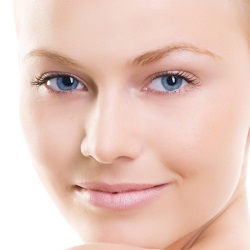Upper-Eyelid Blepharoplasty Surgery to Rejuvenate the Eyelids
Published on January 31, 2017 by FACEOLOGYMD
The eyes and the periorbital area are a focal point in every conversation. Changes in the appearance of your eyelid due to aging might wrongly convey melancholy, tiredness, and absence of vigor. This might diminish the aesthetic appearance of your face. In some cases, excess eyelid skin or herniation of the orbital fat can lead to eyelid ptosis, a condition that can impair the vision.
Age, race, and sex influence the periorbital anatomy. For example, the periorbital region’s cephalometric dimensions are different in men and women. In women, the lid and brow creases are more arched, and the lid fold is also less prominent. In men, the eyebrow protrudes anteriorly and the crease of the eyelid lies closer to its margin.
Your surgeon will evaluate the aesthetic relationships in the periorbital region before performing your upper-lid blepharoplasty.
Are You an Ideal Candidate for the Procedure?
If you are unsure as to whether you are a good fit for the upper-eyelid blepharoplasty procedure, you should schedule an appointment for a consultation with a skilled plastic surgeon. An experienced plastic surgeon will perform a thorough physical exam and order blood tests to see if there is any underlying medical condition that needs to be treated before you have the surgery.
During your consultation, you can discuss your cosmetic goals with your surgeon. You should consider upper-eyelid blepharoplasty if you have excessive sagging and drooping of the skin around your eyes. Sagging skin can also be exacerbated if you have puffy eyes due to edema or allergies.
If you want to undergo an upper-eyelid blepharoplasty for cosmetic reasons, you will need to have realistic expectations. While a cosmetic revival can improve the appearance of your eyes to a great extent, it’s important to remember that no procedure gives you the perfect look.
What Does the Upper-Eyelid Blepharoplasty Procedure Entail?
The surgeon will begin by making an incision in the crease of your upper eyelid. This way, it remains unnoticeable once it has healed. Precise markings will be made to designate the areas where excess fat and skin need to be removed. Some of the underlying muscle will also be removed. The tissue is removed with the help of surgical scissors and scalpels.
Adhesives and sutures are then applied to reshape the areas around the eyebrows and the eyelids. If you suffer from dry eyes, your surgeon will not excise a lot of tissue, as it can expose more of your eye to the air and worsen your symptoms. In cases where the patient has droopy eyebrows, your surgeon might also recommend a brow lift to elevate them and improve the overall appearance of your face.
Post-Operative Care
Have someone drive you home after the surgery. You will need to apply cold compresses to help ameliorate the swelling. Your surgeon will give you detailed instructions that you need to follow. You can resume wearing contact lenses or glasses once the swelling subsides.
Contact Our Office
Contact us to learn more about upper-eye blepharoplasty surgery. Dr. Raymond Lee is double-board-certified in Facial Plastic and Reconstructive Surgery and Otolaryngology. With the help of Dr. Lee, you can rejuvenate your eyelids using this safe and efficient procedure.










